 Investor Presentation April / May 2015 NASDAQ: PBCT Exhibit 99.1 |
 1 Forward-Looking Statement Certain statements contained in this presentation are forward-looking in nature. These include all statements about People's United Financial's plans, objectives, expectations and other statements that are not historical facts, and usually use words such as "expect," "anticipate," "believe," "should" and similar expressions. Such statements represent management's current beliefs, based upon information available at the time the statements are made, with regard to the matters addressed. All forward-looking statements are subject to risks and uncertainties that could cause People's United Financial's actual results or financial condition to differ materially from those expressed in or implied by such statements. Factors of particular importance to People’s United Financial include, but are not limited to: (1) changes in general, national or regional economic conditions; (2) changes in interest rates; (3) changes in loan default and charge-off rates; (4) changes in deposit levels; (5) changes in levels of income and expense in non- interest income and expense related activities; (6) changes in accounting and regulatory guidance applicable to banks; (7) price levels and conditions in the public securities markets generally; (8) competition and its effect on pricing, spending, third-party relationships and revenues; and (9) changes in regulation resulting from or relating to financial reform legislation. People's United Financial does not undertake any obligation to update or revise any forward-looking statements, whether as a result of new information, future events or otherwise. |
 2 Experienced Experienced leadership team leadership team Operate in large & attractive Northeast markets… …with significant …with significant with significant knowledge at the local knowledge at the local level level Commitment to relationship-based banking Breadth of products Breadth of products & services & services Conservative & well- defined underwriting culture Premium brand built Premium brand built over 170 years over 170 years Deep focus on Deep focus on expense management expense management PBCT Differentiators A Uniquely Positioned Franchise |
 3 PBCT: Compelling Investment Opportunity • Leading market position in one of the best commercial banking markets in the U.S. • Significant growth runway within existing markets – expanding in two of the largest MSAs in the U.S. – New York City #1 and Boston #10 • Ability to maintain pristine credit quality – Median net charge-offs/average loans since 2007 have been 18bps • Improving profitability – Five consecutive years of growth in operating earnings per share • Low operating risk profile – Consistently profitable throughout the credit cycle – Straightforward and diversified portfolio of products – no complex financial exposures • Robust liquidity – Strong deposit market share in most core markets – Unused FHLB of Boston borrowing capacity of $5.5 billion at March 31, 2015 • Continued capital deployment via organic growth and dividends – Eighteen consecutive quarters of loan growth – Dividend yield of ~4.5% |
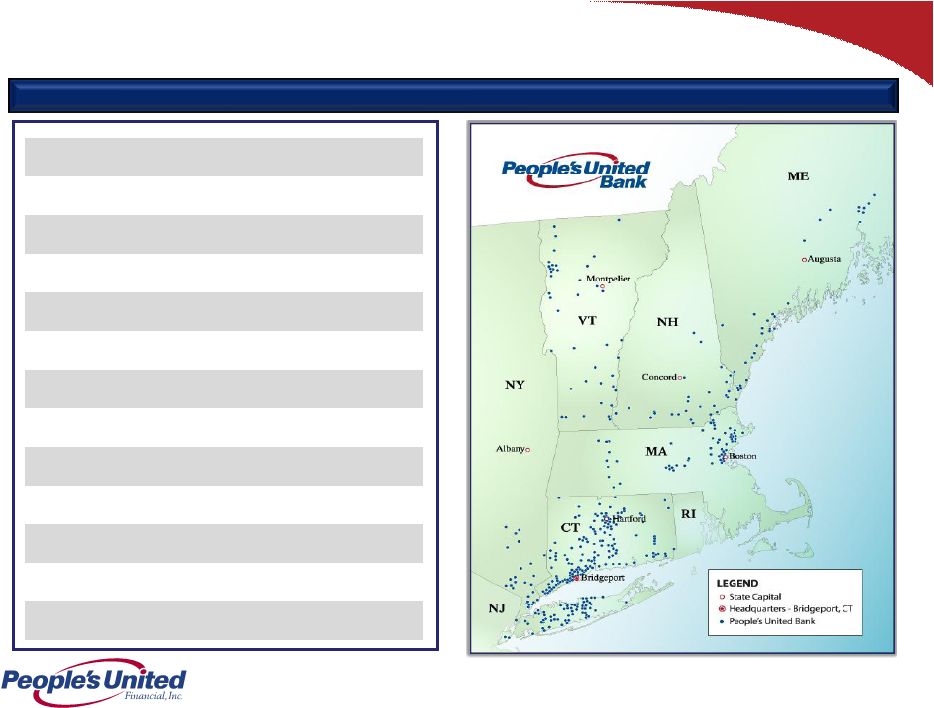 4 Premium Brand Built Over 170 Years Corporate Overview Corporate Overview People’s United Financial, Inc. NASDAQ (PBCT) Headquarters Bridgeport, CT Chief Executive Officer Jack Barnes Chief Financial Officer David Rosato Market Capitalization (04.24.2015) $4.5 billion Assets $36.4 billion Loans $26.9 billion Deposits $27.1 billion Branches 405 In-store Branches (2) 150 ATMs 600 Standalone ATMs (3) 99 Founded 1842 1 Statistics as of March 31, 2015, unless noted otherwise 2 Exclusive relationship with Stop & Shop 3 Includes 14 ATMs in Stop & Shop locations where a branch is not present |
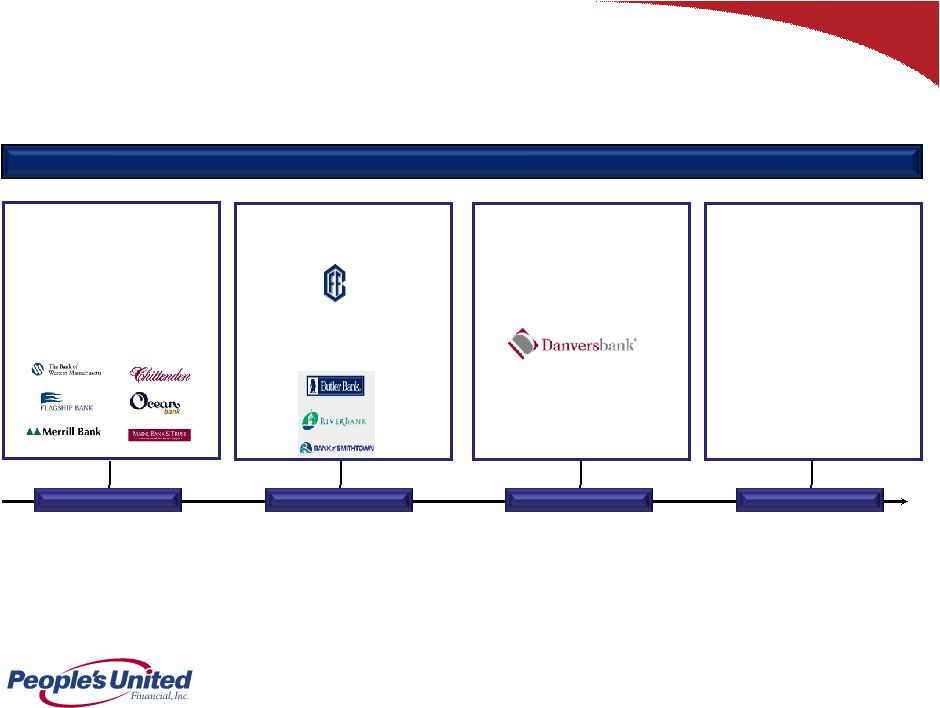 2010 2010 2011 2011 2012 2012 2008 2008 5 Premium Brand Built Over 170 Years Acquired: Chittenden Corp. which comprised: Chittenden Bank – Burlington, VT Ocean Bank – Portsmouth, NH Maine Bank & Trust – Portland, ME Merrill Bank – Bangor, ME Flagship Bank – Worcester, MA Bank of West. Mass. – Springfield, MA Acquired: 57 branches in greater New York metro area from RBS Citizens – including 53 branches in Stop & Shop supermarkets Since 1995, PBCT has had an exclusive relationship with Stop & Shop to operate branches in Connecticut stores Acquired: Danversbank – Danvers, MA Geographic Expansion in Recent Years Acquired: Equipment financing company Financial Federal – New York, NY Acquired: Butler Bank – Lowell, MA RiverBank – North Andover, MA Bank of Smithtown – Smithtown, NY |
 6 Premium Brand Built Over 170 Years In-Store Branches Versus Traditional Branches • Partnership allows us to leverage People’s United brand with the ~3.3 million shoppers who visit Connecticut and New York Stop & Shop stores every week • In-store locations operate under the same business model as traditional branches and sell all the Bank’s products and services • Connecticut and New York in-store branches accounted for a significant portion of the new branch business booked in the market Note: statistics represent Connecticut and New York branches only On average, in-store locations are open 37% more hours per week (56 hours vs. 41 hours), but are 30% less expensive to operate. Last twelve months through March 31, 2015 In-Store Branches Traditional Branches |
 Jack Barnes President & CEO, Director 30+ People’s United Bank (SEVP, CAO), Chittenden, FDIC Galan Daukas SEVP Wealth Management 25+ People’s United Bank, Washington Trust, The Managers Funds, Harbor Capital Mgmt Sara Longobardi SEVP Retail Banking 20+ People’s United Bank Dave Norton SEVP & Chief HR Officer 5+ People’s United Bank, New York Times, Starwood, PepsiCo Lee Powlus SEVP & Chief Administrative Officer 25+ People’s United Bank, Chittenden, Alltel David Rosato SEVP & CFO 25+ People’s United Bank, Webster, Allfirst Chantal Simon SEVP & Chief Risk Officer 25+ People’s United Bank, Merrill Lynch US Bank, Lazard Freres & Co. Jeff Tengel SEVP Commercial Banking 30+ People’s United Bank, PNC, National City Bob Trautmann SEVP & General Counsel 20+ People’s United Bank, Tyler Cooper & Alcorn Kirk Walters SEVP Corporate Development, Director 25+ People’s United Bank, Santander, Sovereign, Chittenden, Northeast Financial Name Name Position Position Years in Banking Years in Banking Professional Experience Professional Experience Experienced Leadership Team 7 |
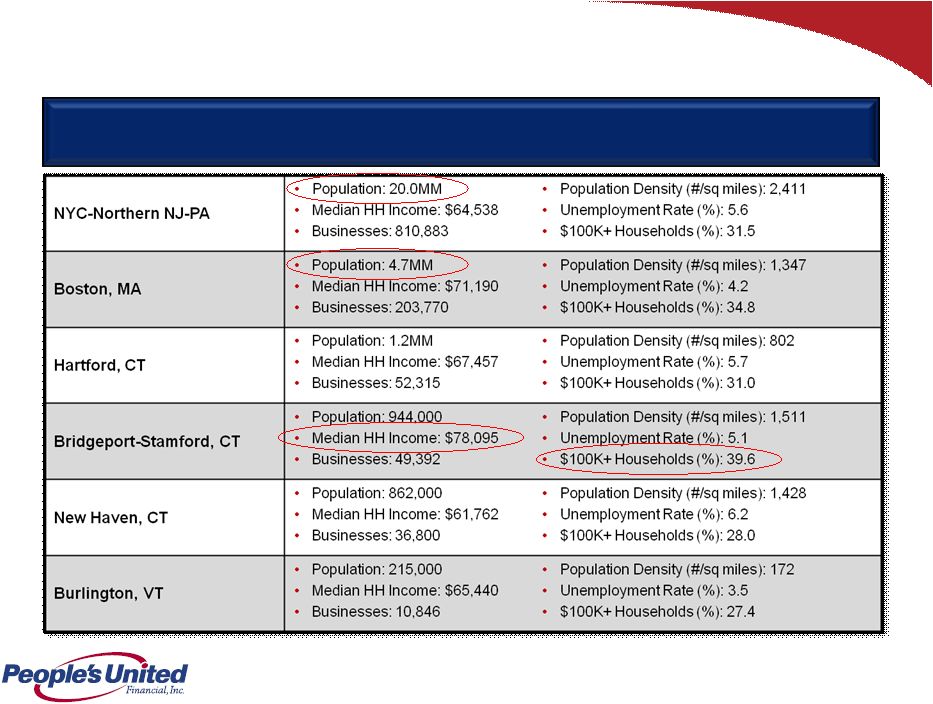 8 Operate in Large & Attractive Northeast Markets Notes: The current national unemployment rate is 5.5% The current national population density is 90 (#/sq miles) Source: SNL Financial, US Census data The population densities of NYC, Boston, Bridgeport and New Haven MSAs are each over ten times the national average |
  9 Operate in Large & Attractive Northeast Markets People’s United’s Franchise Metrics¹ MSA Rank MSA Rank (Out of 917 MSAs Nationwide) (Out of 917 MSAs Nationwide) 75% of PBCT’s deposits are in its top 5 MSAs, which are some of the most densely populated and wealthy markets in the U.S. Source: SNL Financial; Nielsen; FDIC data as of June 30, 2014 1. Excludes deposits from trust institutions and branches with over $750 million deposits; excludes branches and deposits located outside each MSA 2. Rank weighted by percentage of franchise deposits Market Size Population Median % Households People's United Top 5 MSAs Total Deposits Market % Deposit Deposits % of Density Household with $200k+ ($ in millions) Rank Market Share ($ in millions) Franchise (# / sq. mile) Income Income Bridgeport-Stamford-Norwalk, CT $35,390 1 17.9% $6,347 28.8 6 7 2 New York-Newark-Jersey City, NY-NJ-PA 613,008 20 0.5 3,041 13.8 2 34 12 Boston-Cambridge-Newton, MA-NH 131,242 8 2.1 2,784 12.6 8 18 9 Hartford-West Hartford-East Hartford, CT 26,759 4 8.7 2,324 10.6 20 26 21 New Haven-Milford, CT 18,045 4 11.7 2,104 9.6 7 49 34 Top 5 MSAs $824,444 – 2.0% $16,600 75.4 – – – Weighted Average Rank ² – – – – 8 22 12 Rank / Nationwide MSAs (917 MSAs) – – – – 0.8% 2.4% 1.3% |
 10 Total Loan Portfolio: $26.9 Billion Total Loan Portfolio: $26.9 Billion At March 31, 2015 At March 31, 2015 ($ in billions) Connecticut $7.3 / 27% Massachusetts $4.8 / 18% New Hampshire $1.3 / 5% Other $4.7 / 17% New York $5.2 / 19% Vermont $1.8 / 7% New Jersey $0.9 / 3% Maine $0.9 / 4% Operate in Large & Attractive Northeast Markets Excluding equipment finance loans, ~91% of PBCT’s loan portfolio is within the Northeast |
 11 Source: SNL Financial; FDIC data as of June 30, 2014; excludes trust institutions; excludes non-retail branches Notes: PBCT branch count updated as of March 31, 2015 Operate in Large & Attractive Northeast Markets Connecticut Connecticut Massachusetts Massachusetts Vermont Vermont New York New York New Hampshire New Hampshire Maine Maine • 5 th in deposit market share in New England – # 1 in Fairfield County, CT., 65 branches, $7.7 billion in deposits, 20.9% market share Strong deposit market positions Strong deposit market positions Branches $BN % 1 People's United 42 2.7 22.7 2 TD Bank 33 2.5 21.3 3 Merchants 32 1.3 11.2 4 RBS 20 0.8 6.7 5 KeyCorp 13 0.7 5.7 6 Northfield 13 0.5 4.5 7 Community 14 0.5 3.9 8 Union 12 0.4 3.6 9 Passumpsic 6 0.3 3.0 10 Berkshire Hills 6 0.3 2.7 Branches $BN % 1 RBS 73 6.9 24.1 2 TD Bank 72 5.7 19.9 3 B of A 26 4.4 15.4 4 People's United 28 1.4 4.8 5 NH Mutual 19 1.1 3.8 6 BNH 22 1.0 3.4 7 Santander 20 0.8 2.9 8 NH Thrift 21 0.8 2.9 9 Eastern Bank 6 0.8 2.7 10 Mascoma 18 0.7 2.6 Branches $BN % 1 TD Bank 50 3.2 13.3 2 KeyCorp 53 3.0 12.6 3 Bangor Bancorp 59 2.1 8.9 4 Camden National 44 1.9 7.9 5 B of A 18 1.6 6.8 6 First Bancorp 16 1.0 4.3 7 Machias 17 0.9 3.8 8 People's United 26 0.9 3.7 9 Bar Harbor 16 0.8 3.5 10 Norway 24 0.8 3.4 Branches $BN % 1 JPM Chase 799 461.2 37.9 2 Citi 271 79.8 6.6 3 HSBC 149 72.5 6.0 4 B of A 309 65.8 5.4 5 Capital One 264 42.5 3.5 6 M&T 289 39.1 3.2 7 TD Bank 255 27.0 2.2 8 Wells Fargo 87 22.1 1.8 9 Signature 27 18.5 1.5 10 KeyCorp 238 18.1 1.5 27 People's United 101 3.0 0.3 Branches $BN % 1 B of A 146 29.1 25.9 2 Webster 123 13.2 11.8 3 People's United 159 13.0 11.5 4 Wells Fargo 75 8.5 7.6 5 TD Bank 75 6.3 5.6 6 JPM Chase 53 4.9 4.4 7 First Niagara 76 3.9 3.5 8 Citi 17 3.2 2.9 9 Liberty 49 2.9 2.6 10 RBS 46 2.5 2.2 Branches $BN % 1 B of A 238 61.0 25.4 2 RBS 247 27.5 11.4 3 Santander 226 20.1 8.4 4 TD Bank 150 11.5 4.8 5 Eastern Bank 94 7.2 3.0 6 Independent Bank 86 5.7 2.4 7 First Republic 4 4.7 1.9 8 Middlesex 54 3.5 1.5 9 Boston Private 11 3.4 1.4 10 People's United 49 3.2 1.3 |
 12 Commitment to Relationship-Based Banking Offer the superior customer service that is more characteristic of a community oriented bank… • Approximately 850,000 commercial, business banking, consumer and wealth management relationships • Long-term relationships with customers • Customers relationships are with local management • Single point of contact with customers – break down silos to present full suite of products and services • Senior management frequently interacts with customers • Reputation and word-of-mouth referrals often drive new business • Broad distribution: 400+ branches across six states, 600+ ATMs, online and mobile banking • Call center operations locally located in Bridgeport, CT and Burlington, VT |
 13 Breadth of Products & Services Commercial Commercial Banking Banking Retail Retail Banking Banking Wealth Wealth Management Management …while providing the same full breadth of solutions as large banks …while providing the same full breadth of solutions as large banks • Commercial Lending: commercial finance, real estate financing, equipment loans & leasing, asset based lending, mortgage warehouse lending • Deposit Products: checking accounts, savings and money markets accounts • Treasury Management: cash management services, Online banking eTreasury+, ACH services, lockbox services, remote deposit capture, merchant card processing, payroll services, fraud protection services, liquidity and investment solutions • Specialty Services: government banking, healthcare & non-profit banking, interest rate risk management, international services, business aircraft finance • Insurance: commercial coverage, employee benefits, bonding, risk management services, specialized industry insurance • Retail Lending: residential mortgages, home equity loans and lines of credit, personal loans • Deposit Products: checking accounts, savings and money markets accounts • Services: mobile banking, online banking, credit cards • Wealth Services & Solutions: financial planning, trust & estate solutions, investment management, private banking, self-directed investing, retirement plan services, institutional trust services |
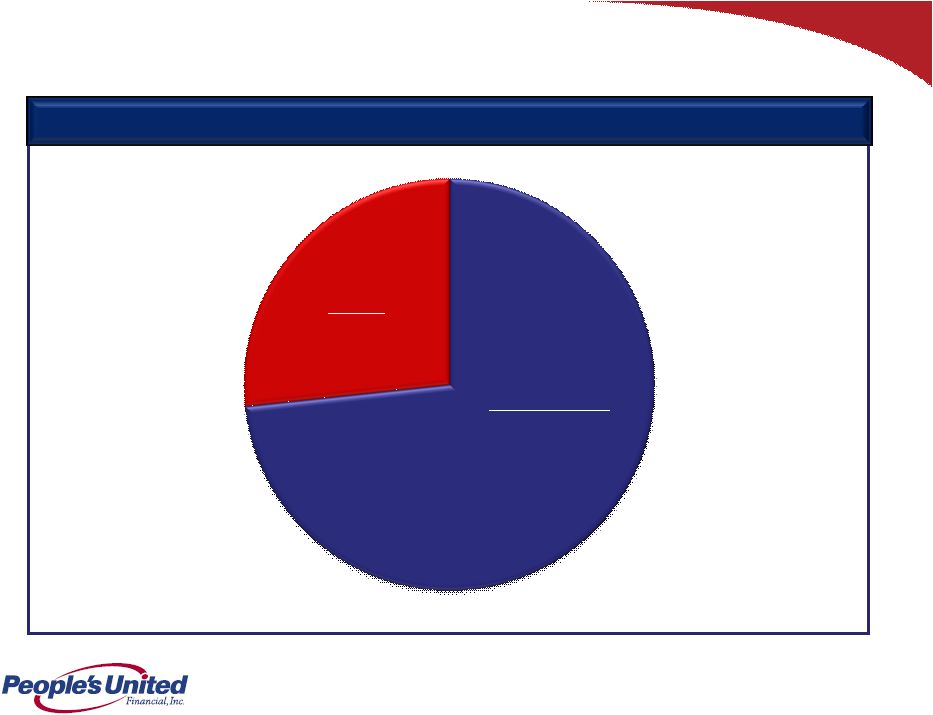 14 Total Loan Portfolio: $26.9 Billion Total Loan Portfolio: $26.9 Billion At March 31, 2015 At March 31, 2015 Commercial Commercial $19.7 Billion / 73% $19.7 Billion / 73% Breadth of Products & Services Retail Retail $7.2 Billion / 27% $7.2 Billion / 27% |
 Transp. / Utility $0.2 / 3% Arts/Ent./Rec. $0.1 / 2% Construction $0.2 / 3% Other Prop. $0.1 / 1% 15 Commercial Real Estate Commercial Real Estate $9.5 Billion / 35% of Total Portfolio $9.5 Billion / 35% of Total Portfolio (At March 31, 2015) Residential (Multi-Family) $3.4 / 36% Commercial & Industrial Commercial & Industrial $7.4 Billion / 28% of Total Portfolio $7.4 Billion / 28% of Total Portfolio Equipment Financing Equipment Financing $2.8 Billion / 10% of Total Portfolio $2.8 Billion / 10% of Total Portfolio Commercial Loans: $19.7 Billion / 73% of Total Portfolio ($ in billions) ($ in billions) ($ in billions) Retail Retail $2.3 / 25% $2.3 / 25% Office Buildings Office Buildings $2.2 / 23% $2.2 / 23% Land $0.1 / 1% Self Storage $0.1 / 1% Mixed / Special Use $0.2 / 2% Hosp. & Entertain. $0.5 / 5% Industrial / Manufacturing $0.6 / 6% Finance & Finance & Insurance Insurance $1.3 / 18% $1.3 / 18% Service Service $1.4 / 18% $1.4 / 18% Manufacturing Manufacturing $1.0 / 13% $1.0 / 13% Wholesale Dist. Wholesale Dist. $0.8/ 11% $0.8/ 11% Health Health $0.8 / 10% $0.8 / 10% Retail Retail Sales Sales $0.6 / 9% $0.6 / 9% Information $0.1 / 1% Public Admin. $0.1 / 1% Packaging $0.1 / 5% Transportation & Utilities $1.0 / 36% Construction Construction $0.4 / 13% $0.4 / 13% Finance, Finance, Ins. & RE Ins. & RE $0.3 / 11% $0.3 / 11% Waste Waste $0.2 / 7% $0.2 / 7% Printing Printing $0.2 / 7% $0.2 / 7% Manufacturing Manufacturing $0.2 / 6% $0.2 / 6% Wholesale Wholesale Dist. Dist. $0.1 / 5% $0.1 / 5% Mining, Oil & Gas $0.1 / 3% Service $0.1 / 2% Other $0.2 / 5% Breadth of Products & Services Broadly diversified commercial loan portfolio Broadly diversified commercial loan portfolio Real Estate Real Estate $0.8 / 11% $0.8 / 11% |
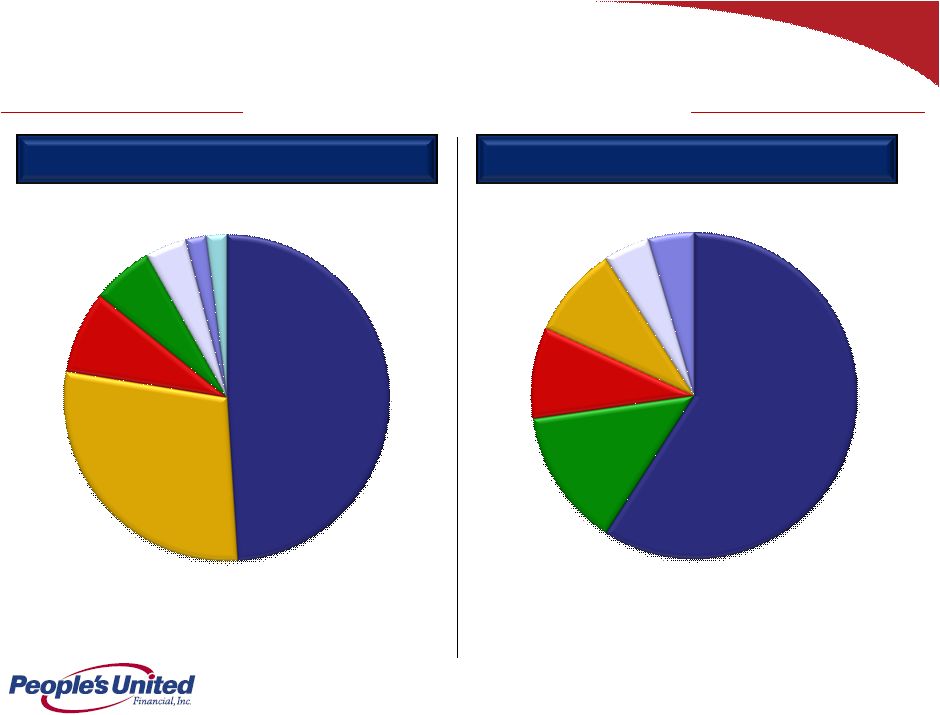 16 Residential Mortgage $5.0 Billion / 19% of Total Portfolio $5.0 Billion / 19% of Total Portfolio (At March 31, 2015) Retail Loans: $7.2 Billion / 27% of Total Portfolio ($ in billions) ($ in billions) Consumer $2.2 Billion / 8% of Total Portfolio $2.2 Billion / 8% of Total Portfolio March 2015 YTD originated weighted average LTV of 67% March 2015 YTD originated weighted average FICO score of 769 Hybrid ARMs represent ~90% of the portfolio March 2015 YTD originated weighted average CLTV of 58% March 2105 YTD originated weighted average FICO score of 769 ~60% of originations during last 3 years are in a first lien position New York New York $0.5 / 9% $0.5 / 9% Vermont Vermont $0.3 / 6% $0.3 / 6% Massachusetts Massachusetts $1.4 / 28% $1.4 / 28% Connecticut Connecticut $2.4 / 48% $2.4 / 48% Connecticut Connecticut $1.3 / 60% $1.3 / 60% Vermont Vermont $0.3 / 10% $0.3 / 10% New York New York $0.2 / 10% $0.2 / 10% Massachusetts Massachusetts $0.2 / 8% $0.2 / 8% New Hampshire $0.2 / 4% Maine $0.1 / 3% Other $0.1 / 2% New Hampshire $0.1 / 6% Maine $0.1 / 6% Breadth of Products & Services |
 17 Conservative & Well-Defined Underwriting Culture • Credit culture and underwriting standards – Cash flow – deal specific and global – Collateral / limited unsecured exposure with equity investment requirements and guarantees – No speculative real estate projects • Credit structure includes meaningful covenants, appropriate LTVs and monitored advance rates • Industry knowledge and expertise (i.e. basic industries and property types) • Seasoned relationship managers with considerable local market knowledge • Experienced senior credit officers (SCO) average 25+ years of commercial banking experience • Approval authority – Local, regional and corporate credit committee structure – >$25 million also requires Executive Risk Oversight Committee approval • Due diligence begins prior to the issuance of a proposal (market manager & SCO) and independent credit associates in Risk Management are utilized • Credit analyst / relationship manager complete detailed loan submission • Stress test cash flow for interest rate sensitivities, vacancy and rental rates • Independent field exams and appraisal review Commercial Credit Culture & Approval Process Commercial Credit Culture & Approval Process |
 18 Conservative & Well-Defined Underwriting Culture Conservative underwriting is a hallmark of People’s United Conservative underwriting is a hallmark of People’s United Average Annual Net Charge-Offs / Average Loans Peer Group Comparison 2010-2014 |
 19 Deep Focus on Expense Management • EMOC has been fully operational since November 2011 – Committee comprised of the CEO, CFO, Chief Administrative Officer and Chief HR Officer • EMOC oversees: – Non-interest expense management and implements strategies to attain targeted goals – Revenue initiatives that require expenditures and conducts periodic progress reviews • Provides a horizontal view of the organization • Expense Management Units (EMUs) established to facilitate EMOC functions – Defined EMUs include: • Technology • Operations • Real Estate Services • Spending requests above $25,000 are submitted by EMU owners for approval • Staffing models, staffing replacements and additions for mid-level positions and above require approval by the Committee Expense Management Oversight Committee (EMOC) Expense Management Oversight Committee (EMOC) Proactive expense management approach Proactive expense management approach |
 20 Deep Focus on Expense Management • People’s United has managed expenses while also making significant investments in: People and systems amidst a regulatory environment of heightened expectations Revenue and deposit gathering initiatives Improving customer experiences via enhanced delivery of products and services Operating Non-Interest Expenses Operating expenses have remained flat despite continued strategic investments and increasing regulatory compliance costs |
 21 • Bolstering commercial banking presence in Massachusetts and New York • Building large-corporate and government banking productivity • Filling in New York metro Commercial Real Estate presence • Continuing to leverage investment in asset-based lending • Focusing on deposit gathering capabilities • Growing wealth management fee income • Increasing momentum in other fee income businesses – Transitioning Insurance to a more specialized model – Delivering interest rate swaps and foreign exchange products to corporate customers – Expanding international trade finance – Growing commercial banking lending fees – Investing in competitive cash management products These significant opportunities expected to provide earnings growth for years to come Significant Opportunities Growing in larger markets (New York metro & greater Boston), while deepening presence in heritage markets such as Connecticut and Vermont |
 22 Building the Franchise for the Long-Term Committed to delivering value to both customers and shareholders Committed to delivering value to both customers and shareholders • Increase focus on relationship profitability – Continue to build deep, multi-product relationships with an emphasis on cross-sell – Deposit gathering remains a key focus and is reflected in incentive structure • Maintain pristine asset quality • Tightly control expenses while investing in key infrastructure • Maintain asset sensitivity to position People’s United for rising interest rates |
 First Quarter 2015 Results |
 24 First Quarter 2015 Overview • Operating earnings of $63.2 million, an increase of 12% from the prior year quarter • Net interest income¹ of $228 million, consistent with recent quarters • Net interest margin of 2.91%, a decrease of 9 basis points • Loan growth of $337 million, 5.1% annualized growth rate • Organic deposit growth of $1.0 billion, 17.3% annualized growth rate • Non-interest income of $89 million, increased 3% from the fourth quarter and 11% from the prior year quarter • Operating expenses of $212 million, a modest increase due to traditionally higher first quarter costs, but flat compared to the prior year quarter • Efficiency ratio was 61.9%, a slight increase from 61.3%, but improved from 63.9% in the prior year quarter • Net loan charge-offs were 0.11%, an improvement from 0.13% (Comparisons versus fourth quarter 2014, unless noted differently) 1 Net interest income on a fully taxable equivalent basis for 4Q 2014 and 1Q 2015 was $233.2 million and $233.9 million, respectively. |
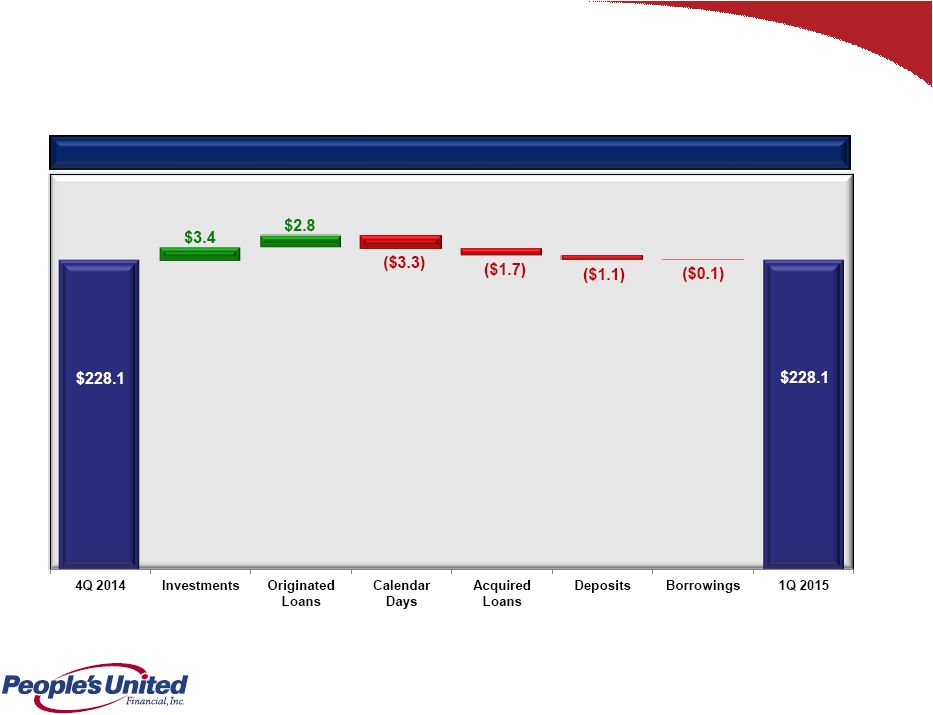 25 Net Interest Income 1 ($ in millions) Linked Quarter Change Linked Quarter Change 1 Net interest income on a fully taxable equivalent basis for 4Q 2014 and 1Q 2015 was $233.2 million and $233.9 million, respectively. |
 26 Net Interest Margin Linked Quarter Change Linked Quarter Change |
 27 Loans ($ in millions) Linked Quarter Change Linked Quarter Change Annualized linked quarter change: +5.1% |
 28 Deposits Linked Quarter Change Linked Quarter Change ($ in millions) Annualized linked quarter change: +15.5% 1 Commercial includes Municipal deposits of $1,458 at 12/31/2014 and $1,608 at 3/31/2015 2 Retail includes brokered deposits of $2,633 at 12/31/2014 and $2,629 at 3/31/2015 |
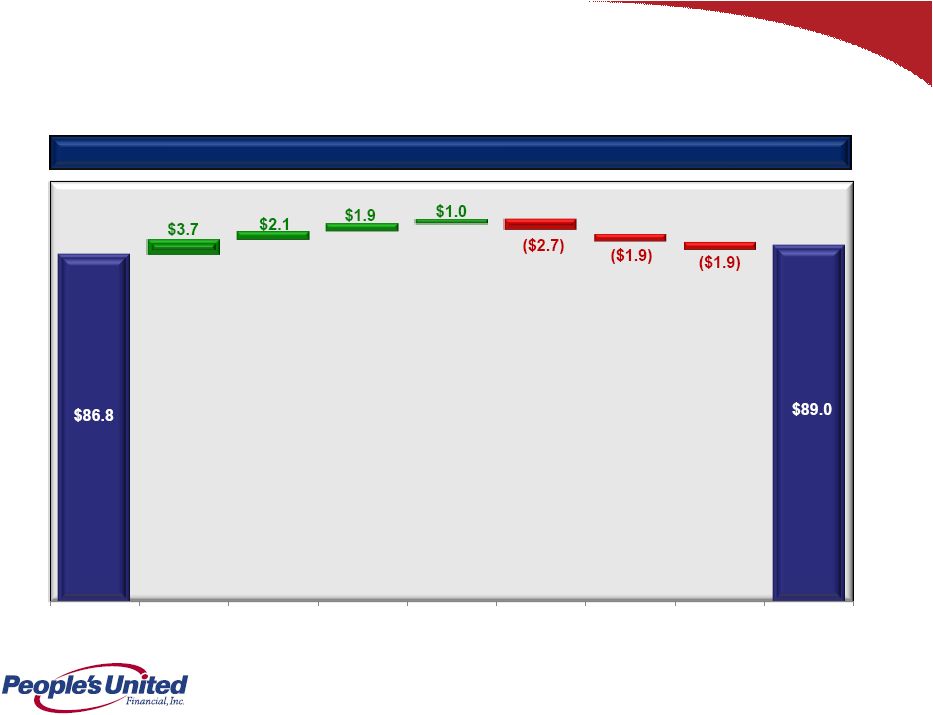 29 Non-Interest Income ($ in millions) Linked Quarter Change Linked Quarter Change 4Q 2014 Commercial Banking Lending Fees Customer Interest Rate Swap Income Net Gain on Sale of Loans Insurance Net Security Gains Bank Service Charges Other 1Q 2015 |
 30 Non-Interest Expense ($ in millions) Linked Quarter Change Linked Quarter Change Operating Non-Operating |
 31 Efficiency Ratio |
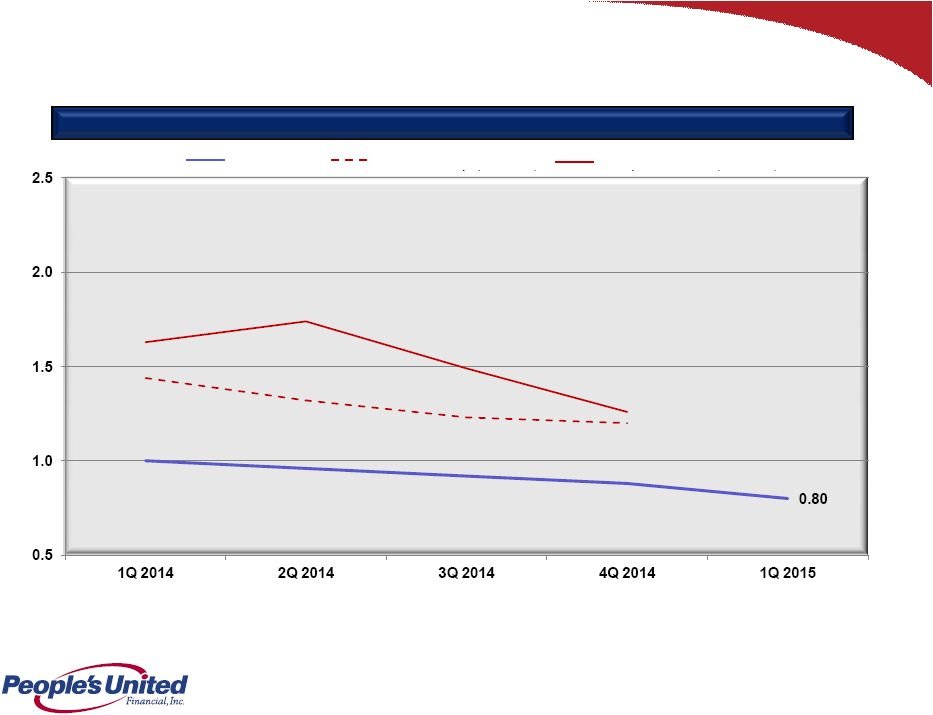 32 Asset Quality NPAs / Loans & REO (%) 1 1 Non-performing assets (excluding acquired non-performing loans) as a percentage of originated loans plus all REO and repossessed assets; acquired non-performing loans excluded as risk of loss has been considered by virtue of (i) our estimate of acquisition-date fair value, (ii) the existence of an FDIC loss sharing agreement, and/or (iii) allowance for loan losses established subsequent to acquisition Source: SNL Financial and Company filings Notes: Top 50 Banks represents the largest 50 banks by total assets in each respective quarter PBCT Peer Group (Median) Top 50 Banks (Median) |
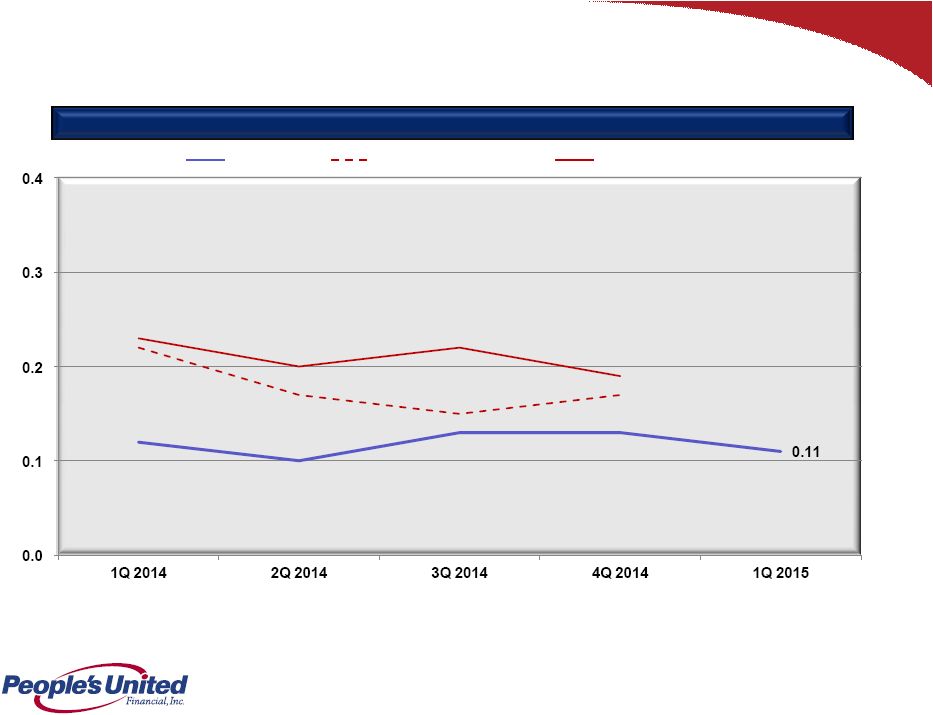 33 Asset Quality Net Charge-Offs / Average Loans (%) 1 1 Excluding acquired loan charge-offs, PBCT’s charge-off ratio was 0.11%, 0.13%, 0.12%, 0.09%, and 0.09%, in 1Q 2015, 4Q 2014, 3Q 2014, 2Q 2014, and 1Q 2014, respectively Source: SNL Financial and Company filings Notes: Top 50 Banks represents the largest 50 banks by total assets in each respective quarter PBCT Peer Group (Median) Top 50 Banks (Median) |
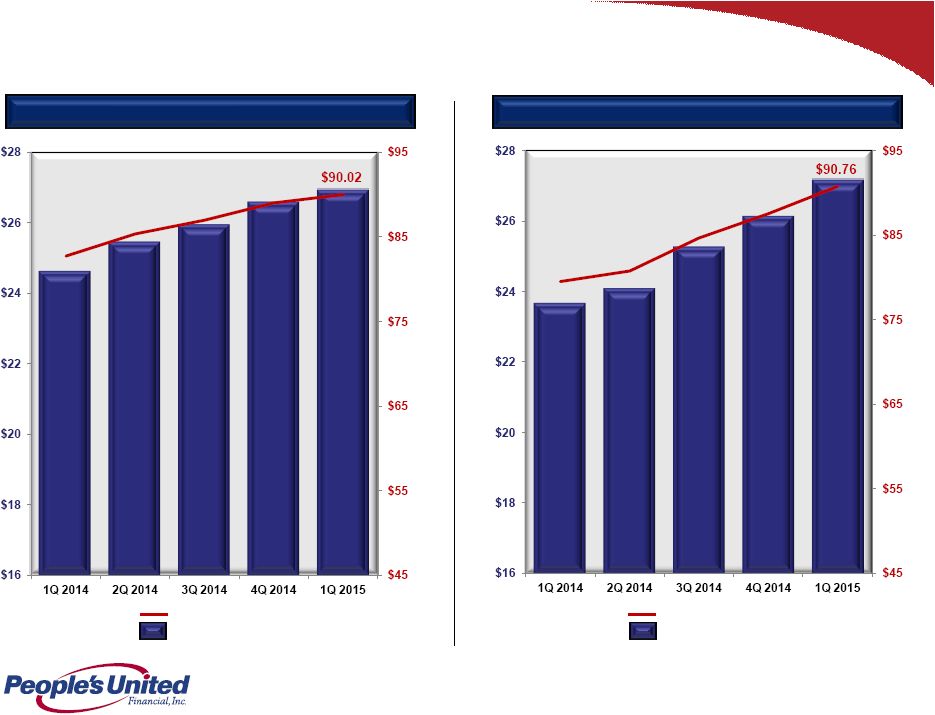 34 Growing Future Earnings Per Share Loans Loans Deposits Deposits Deposits per Share Loans per Share Loans ($ in billions) Deposits ($ in billions) |
 35 Operating Return on Average Assets |
 36 Operating Return on Average Tangible Equity |
 37 Capital Ratios (Effective January 1, 2015, all ratios calculated in accordance with Basel III) Basel III Notes: 1. Tier 1 Leverage ratio represents Tier 1 Capital divided by Average Total Assets (less goodwill, other acquisition-related intangibles and other deductions from Common Equity Tier 1 Capital) 2. Common Equity Tier 1 Capital ratio represents total stockholder’s equity, excluding: (i) after-tax net unrealized gains (losses) on certain securities classified as available for sale; (ii) goodwill and other acquisition- related intangibles; and (iii) the amount recorded in accumulated other comprehensive income (loss) relating to pension and other postretirement benefits divided by Total Risk-Weighted Assets 3. Tier 1 Risk-Based Capital ratio represents Common Equity Tier 1 Capital plus additional Tier 1 Capital (together, "Tier 1 Capital") divided by Total Risk-Weighted Assets 4. Total Risk-Based Capital ratio represents Tier 1 Capital plus subordinated notes and debentures, up to certain limits, and the allowance for loan losses, up to 1.25% of Total Risk-Weighted Assets, divided by Total Risk-Weighted Assets 5. Well capitalized limits under Basel III capital rules are: Tier 1 Leverage Ratio, 5%; Common Equity Tier 1 Capital Ratio, 6.5%; Tier 1 Risk-Based Capital Ratio, 8%; and Total Risk-Based Capital Ratio, 10% 1Q 2014 2Q 2014 3Q 2014 4Q 2014 1Q 2015 People’s United Financial Tang. Com. Equity/Tang. Assets 8.0% 7.9% 7.8% 7.5% 7.5% Tier 1 Leverage 1, 5 8.4% 8.3% 8.1% 7.9% 8.3% Common Equity Tier 1 Capital 2, 5 10.1% 10.0% 9.9% 9.8% 10.0% Tier 1 Risk-Based Capital 3, 5 10.1% 10.0% 9.9% 9.8% 10.0% Total Risk-Based Capital 4, 5 11.2% 12.5% 12.3% 12.2% 12.0% People’s United Bank Tier 1 Leverage 1, 5 9.1% 9.0% 8.8% 8.5% 8.8% Common Equity Tier 1 Capital 2, 5 11.0% 10.8% 10.7% 10.5% 10.6% Tier 1 Risk-Based Capital 3, 5 11.0% 10.8% 10.7% 10.5% 10.6% Total Risk-Based Capital 4, 5 12.2% 13.5% 13.3% 13.0% 13.1% |
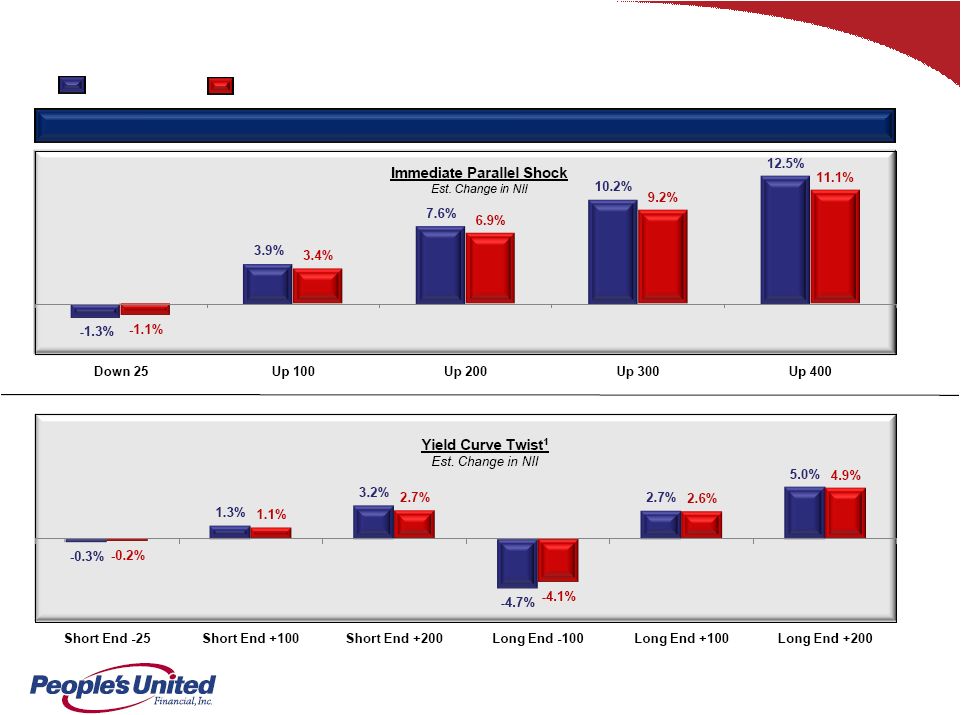 38 Interest Rate Risk Profile Net Interest Income (NII) Sensitivity Net Interest Income (NII) Sensitivity 1 Yield curve twist pivot point is 18 month point on yield curve. Short End defined as overnight to 18 months. Long End defined as terms greater than 18 months. Mar. 31, 2015 Dec. 31, 2014 |
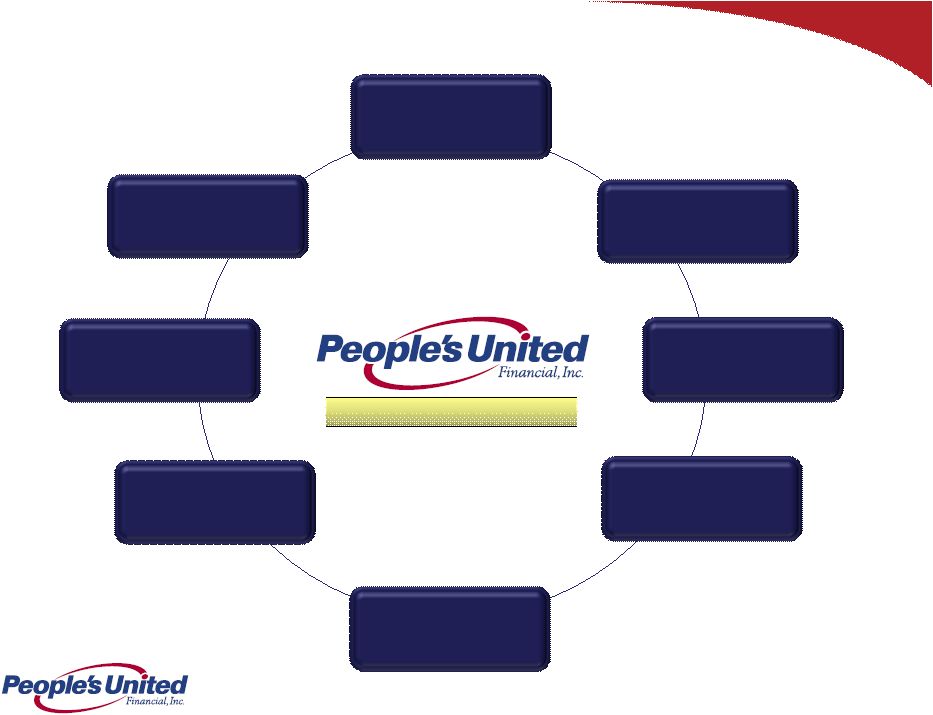 39 Experienced Experienced leadership team leadership team Operate in large & attractive Northeast markets… …with significant …with significant with significant knowledge at the local knowledge at the local level level Commitment to relationship-based banking Breadth of products Breadth of products & services & services Conservative & well- defined underwriting culture Premium brand built Premium brand built over 170 years over 170 years Deep focus on Deep focus on expense management expense management Summary A Uniquely Positioned Franchise |
 Appendix |
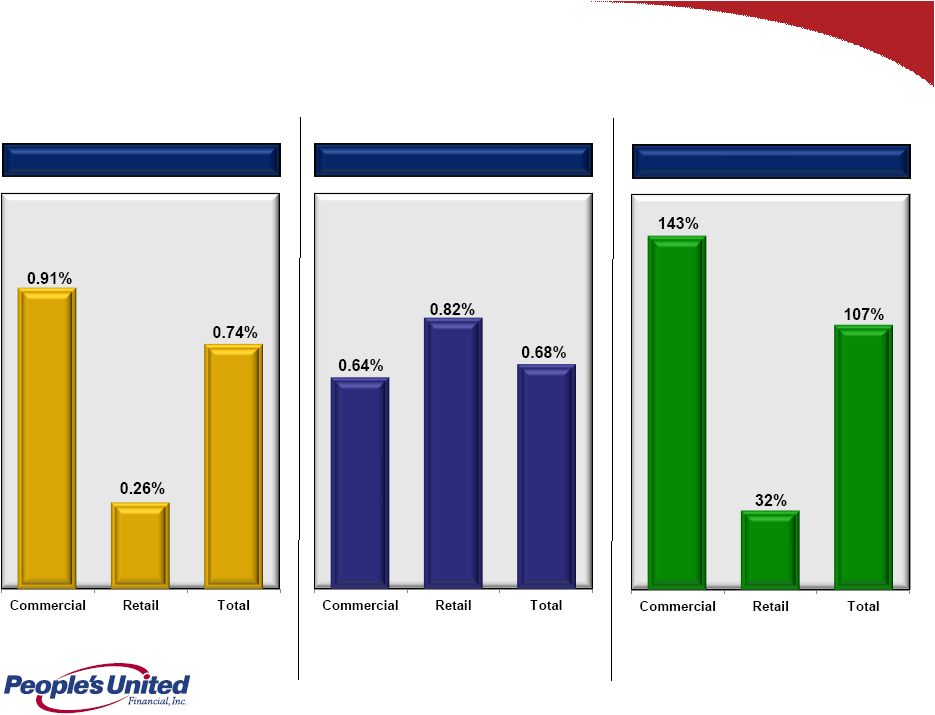 41 Asset Quality Originated Portfolio Coverage Detail as of March 31, 2015 ALLLs / Loans ALLLs / Loans NPLs / Loans NPLs / Loans ALLLs / NPLs ALLLs / NPLs Note – ALLLs: Commercial: $173 million, Retail: $18 million, Total: $191 million |
 Bonds, Notes & Debentures $0.3 / 5% 42 Securities Portfolio Detail Note: Duration of the securities portfolio is ~4 years Securities portfolio does not contain CLOs, CDOs, trust preferred, or private-label mortgage-backed securities Held to maturity (HTM) securities reported on an amortized cost basis (book value). Available for sale (AFS) securities reported at fair value Numbers may not sum due to rounding Agency CMO’s $1.8 / 33% Agency MBS & Agency CMOs comprised of 10-yr & 15-yr collateral constitute ~78% of the portfolio. Municipal bond portfolio has an underlying weighted average credit rating above AA . . Securities Portfolio: $5.6 Billion Securities Portfolio: $5.6 Billion At March 31, 2015 At March 31, 2015 ($ in billions) Agency MBS Agency MBS $2.2 / 40% $2.2 / 40% Municipal - HTM $0.9 / 16% FHLB & Federal Reserve Bank Stock $0.3 / 5% |
 43 Balance Sheet Funding 81% funded by organic deposits, customer repurchase agreements and common equity . . Balance Sheeting Funding: $36.4 Billion Balance Sheeting Funding: $36.4 Billion At March 31, 2015 At March 31, 2015 ($ in billions) Retail Deposits Retail Deposits $16.7 / 46% $16.7 / 46% Brokered Deposits $2.6 / 7% Commercial Deposits Commercial Deposits $7.8 / 21% $7.8 / 21% Shareholders’ Equity $4.7 / 13% Fed Funds & FHLB Fed Funds & FHLB Advances Advances $2.7 / 8% $2.7 / 8% Subordinated Borrowings & Senior Notes $1.0 / 3% Customer Repurchase Agreements $0.5 / 1% Other Liabilities $0.4 / 1% |
 44 Peer Group Firm Ticker City State 1 Associated ASB Green Bay WI 2 BancorpSouth BXS Tupelo MS 3 City National CYN Los Angeles CA 4 Comerica CMA Dallas TX 5 Commerce CBSH Kansas City MO 6 Cullen/Frost CFR San Antonio TX 7 East West EWBC Pasadena CA 8 First Niagara FNFG Buffalo NY 9 FirstMerit FMER Akron OH 10 Fulton FULT Lancaster PA 11 Huntington HBAN Columbus OH 12 M&T MTB Buffalo NY 13 New York Community NYCB Westbury NY 14 Signature SBNY New York NY 15 Susquehanna SUSQ Lititz PA 16 Synovus SNV Columbus GA 17 Valley National VLY Wayne NJ 18 Webster WBS Waterbury CT 19 Wintrust WTFC Lake Forest IL 20 Zions ZION Salt Lake City UT |
 45 Non-GAAP Financial Measures and Reconciliation to GAAP In addition to evaluating People’s United Financial’s results of operations in accordance with U.S. generally accepted accounting principles (“GAAP”), management routinely supplements this evaluation with an analysis of certain non- GAAP financial measures, such as the efficiency and tangible equity ratios, tangible book value per share and operating earnings metrics. Management believes these non-GAAP financial measures provide information useful to investors in understanding People’s United Financial’s underlying operating performance and trends, and facilitates comparisons with the performance of other financial institutions. Further, the efficiency ratio and operating earnings metrics are used by management in its assessment of financial performance, including non-interest expense control, while the tangible equity ratio and tangible book value per share are used to analyze the relative strength of People’s United Financial’s capital position. The efficiency ratio, which represents an approximate measure of the cost required by People’s United Financial to generate a dollar of revenue, is the ratio of (i) total non-interest expense (excluding goodwill impairment charges, amortization of other acquisition-related intangible assets, losses on real estate assets and non-recurring expenses) (the numerator) to (ii) net interest income on a fully taxable equivalent ("FTE") basis plus total non-interest income (including the FTE adjustment on bank-owned life insurance ("BOLI") income, and excluding gains and losses on sales of assets other than residential mortgage loans and acquired loans, and non-recurring income) (the denominator). In addition, operating lease expense is excluded from total non-interest expense and netted against operating lease income within non-interest income to conform with the reporting approach applied to fee-based businesses already presented on a net basis. People’s United Financial generally considers an item of income or expense to be non-recurring if it is not similar to an item of income or expense of a type incurred within the last two years and is not similar to an item of income or expense of a type reasonably expected to be incurred within the following two years. |
 46 Non-GAAP Financial Measures and Reconciliation to GAAP Operating earnings exclude from net income those items that management considers to be of such a non-recurring or infrequent nature that, by excluding such items (net of income taxes), People’s United Financial’s results can be measured and assessed on a more consistent basis from period to period. Items excluded from operating earnings, which include, but are not limited to, non-recurring gains/losses, merger-related expenses (including acquisition integration and other costs), charges related to executive-level management separation costs, severance-related costs and writedowns of banking house assets, are generally also excluded when calculating the efficiency ratio. Operating earnings per share is derived by determining the per share impact of the respective adjustments to arrive at operating earnings and adding (subtracting) such amounts to (from) GAAP earnings per share. Operating return on average assets is calculated by dividing operating earnings (annualized) by average assets. Operating return on average tangible stockholders' equity is calculated by dividing operating earnings (annualized) by average tangible stockholders' equity. The operating dividend payout ratio is calculated by dividing dividends paid by operating earnings for the respective period. The tangible equity ratio is the ratio of (i) tangible stockholders’ equity (total stockholders’ equity less goodwill and other acquisition-related intangible assets) (the numerator) to (ii) tangible assets (total assets less goodwill and other acquisition-related intangible assets) (the denominator). Tangible book value per share is calculated by dividing tangible stockholders’ equity by common shares (total common shares issued, less common shares classified as treasury shares and unallocated Employee Stock Ownership Plan ("ESOP") common shares). In light of diversity in presentation among financial institutions, the methodologies used by People’s United Financial for determining the non-GAAP financial measures discussed above may differ from those used by other financial institutions. Please refer to People’s United Financial’s latest Form 10-Q regulatory filing for detailed reconciliations to GAAP figures. |
 For more information, investors may contact: Andrew S. Hersom (203) 338-4581 andrew.hersom@ peoples.com NASDAQ: PBCT |